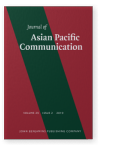Vol. 29:2 (2019) ► pp.211–229
English within Japanese
Loanwords from English in Japanese as a vocabulary pool for EFL education
The present study examined English textbooks used in Japanese middle and high schools, and analyzed to what extent the English words that are included in those textbooks are already integrated into the vocabulary pool of Japanese as loanwords. The findings of the present study showed that approximately 80% of the English words introduced in the first four years of English education in schools in Japan are already integrated into Japanese as loanwords. Based on this high percentage of English words with loanword counterparts in Japanese, the present study has argued that English loanwords in Japanese can be used as a resource for learning new vocabulary in the field of EFL education for L1 speakers of Japanese.
Article outline
- 1.Introduction and background
- 1.1Loanwords from English in Japanese
- 1.2EFL education in Japan and loanwords from English
- 2.Present study
- 3.Results
- 4.Discussion and pedagogical implications
- 5.Conclusion
- Notes
-
References
